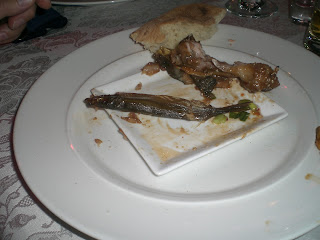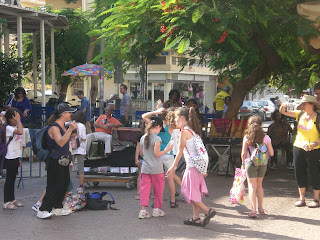For forty years, as our ancestors traversed the Sinai Desert prior to their entry into the Holy Land, miraculous "clouds of glory" surrounded and hovered over them, shielding them from the dangers and discomforts of the desert. Ever since, we remember
God's kindness and reaffirm our trust in His providence by dwelling in a sukkah
– a hut of temporary construction with a roof-covering of branches – for the duration of the autumn
Sukkot festival. For seven days and nights, we eat all our meals in the
sukkah – reciting a special blessing – and otherwise regard it as our home.
We reaffirm our trust in His providence by dwelling in a sukkah. Another
mitzvah that is unique to Sukkot is the taking of the Four Kinds: an
etrog (citron), a
lulav (palm frond), at least three
hadassim (myrtle branches) and two
aravot (willow branches). The
Midrash tells us that the Four Kinds represent the various types and personalities that comprise the community of
Israel, whose intrinsic unity we emphasize on Sukkot.
On each day of the festival (except
Shabbat), during the daytime hours, we take the Four Kinds, recite a blessing over them, bring them together in our hands and wave them in all six directions: right, left, forward, up, down and to the rear. (The Four Kinds are also an integral part of the holiday's daily morning service.)
Sukkot is also called The Time of Our Joy; indeed, a special joy pervades the festival. Nightly Water-Drawing Celebrations, reminiscent of the evening-to-dawn festivities held in the Holy Temple in preparation for the drawing of water for use in the festival service, fill the synagogues and streets with song, music, and dance until the wee hours of the morning.
Sukkot runs from the fifteenth through the twenty-first of
Tishrei. The first two days of this festival (in Israel only the first day) are a major holiday, when most forms of work are prohibited. On the preceding nights, women and girls light candles, reciting the appropriate blessings, and we enjoy nightly and daily festive meals, accompanied by the
Kiddush.
Celebrations fill the streets with song and dance until the wee hours of the morning. The remaining days of the festival are Chol Hamoed ("intermediate days"), when most forms of work are permitted. We try to avoid going to work, writing, and certain other activities – many families use this time to enjoy fun family outings








































